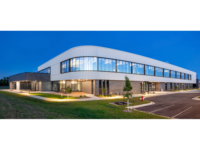When singer/songwriter Jan Edwards expanded her property in Plymouth, Minn., to include the Moonacy Music Room performance space, aesthetics, a state-of-the-art sound system and optimized acoustics were vital. Designed to represent the four elements—earth, water, air and fire—the Moonacy Music Room is a collaborative venue for songwriter workshops, video conferencing, house concerts, fundraising for music-related nonprofits and private events. To achieve optimum acoustics, the design and engineering team incorporated FABRITEC Wall Panels and willtec strips from pinta acoustic into the art and décor.
The concept for the room began to take shape when Edwards had purchased an 18-foot by 9-foot colorful Native American painting created by Rabbett Before Horses Strickland, an Ojibwa artist from northern Wisconsin. Called “The Right to Consciousness,” this artwork was central to the space. The creative process evolved during a brainstorming session between Edwards, architect Alex Haecker and interior designers Shelly Reihl David and Carl David. Edwards introduced a magazine tear sheet with a quilted wall. This was the impetus behind what has been named the magic wall.
The magic wall contains nearly 400 squares of custom FABRITEC acoustical tiles wrapped in 11 different textured and colored fabrics. To add movement to the wall, Luke Nelson from Acoustic Vision recommended incorporating 19 Planar digital screens intermixed with the acoustical panels. These digital screens were programmed to display atmospheric images, such as the murmuring of starlings or a rolling storm. The video images on the magic wall represent the element air.
It’s All in the Design
The music room was designed with angled walls, exposed metal trusses, a shiplap ceiling that increases in elevation from 11 to 17 feet and an epoxy-coated concrete floor. The wall behind the stage contains a 98-inch digital display from Planar, flanked by large twin guitar cabinets made with glass and reclaimed wood from a tobacco barn in Virginia. Reclaimed wood was also used to build the stage and wide baseboards and wainscoting. To allow natural light in, the space includes a wall of windows opposite the stage. The wood of the stage and cabinets, and the wood instruments symbolize the element earth.
The shape of the space, along with many hard, reflective surfaces, posed acoustical challenges. To address them, Nelson brought in audio engineer and classically trained cellist Charles G. (Skip) Kahane from PGS/Broadcast Media Services. Kahane recommended pinta acoustic’s wall tiles, willtec panels and willduct HVAC ductwork thermal and sound insulation for the Moonacy Music Room.
“The increasing rise of the ceiling, and ending in a glass wall, gave the space a megaphone-like characteristic,” explains Kahane. “In music venues, we typically treat the stage first and the wall opposing the stage second. We were unable to do that because of the guitar cabinets and large display on the stage and the facing glass wall.”
Efficiency
To treat the space, Kahane specified 15½- by 15½- by 1-inch panels for the magic wall. These tiles were custom-wrapped in the materials selected by interior designer David. 10.375-inch-wide willtec strips, faced with a superwhite HPC coating, were directly applied using adhesive in a pattern to blend with the white shiplap ceiling. Additional 1.5-inch-thick acoustical panels were nested in the frame behind the artwork using string tacked in a zigzag pattern across the back of the frame. Testing after acoustical treatment reveals a reverberation time of .74.
“Many of the panels were shipped from pinta acoustic with the custom fabric fully wrapped on the top and edges,” says Devin Jackson, acoustical engineer and owner of Jackson Sound Management Productions. “Additional panels were supplied with the fabric secured only to the top. This allowed us to custom-cut the tiles to fit the ceiling and wall lines. Once cut to size, panels were finished by wrapping and adhering the fabric to the edges. Each tile was direct-applied to the wall using pinta’s acouSTIC adhesive. The willtec strips on the ceiling were also cut in the field to fit around the metal tresses and other fixtures.”
“The fourth element, fire, is depicted in the bar that was created by a local sculptor, James Lamis. Also a light display casts the image of fire onto the draperies behind the bar. Unique hanging light fixtures simulate charred tree branches,” explains Edwards. “One of my favorite features is the aquarium that’s on the same wall as the painting. It exhibits specimens of beautiful koi and a replica of the Moonacy Music Room on a cliff. The painting by Rabbett, aquarium and the powder room symbolize water.”
Performing Better
Made of the company’s willtec foam core, the wall panels offer strong acoustical performance, absorbing up to 85 percent of the sound directed toward them. Available in custom and standard sizes, the panels are impact resistant and have a tackable surface.
The foam is Class 1 fire-rated and available in natural white or light grey with an optional HPC coating in standard and custom colors. Panel sizes can be any dimension up to 48 by 96 inches, and typical thicknesses range between 2 and 3 inches. Custom shapes, colors and sizes are available.
The product was also used to absorb background noise caused by HVAC fans and blowers. Resistant to mold and mildew, the product passes UL 181, is easy to install in HVAC ductwork and provides thermal and sound insulation.











